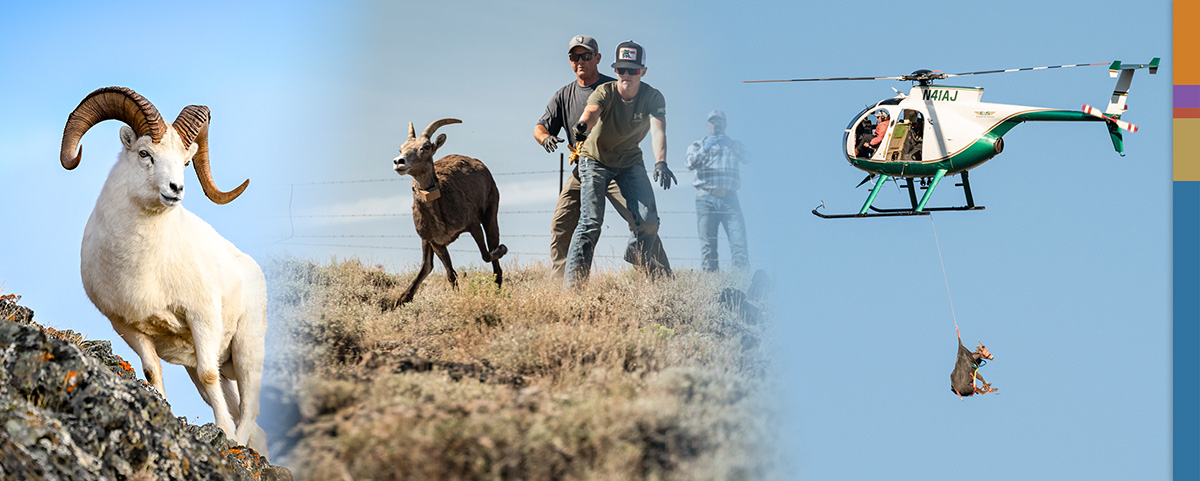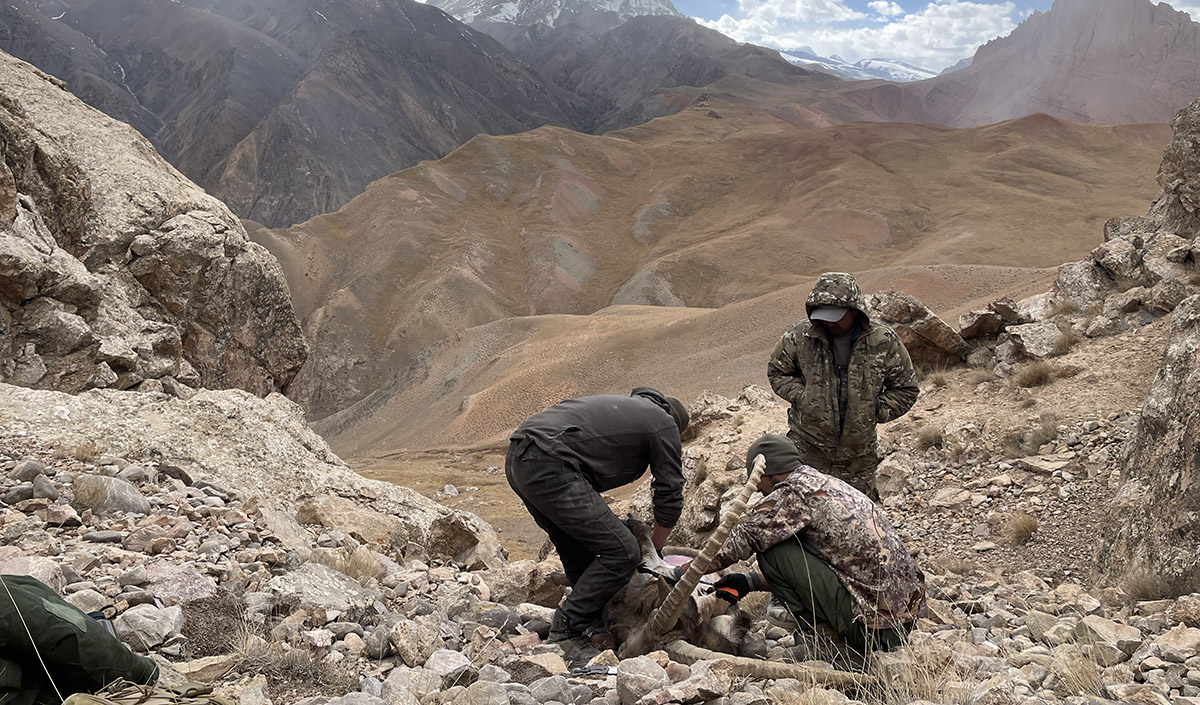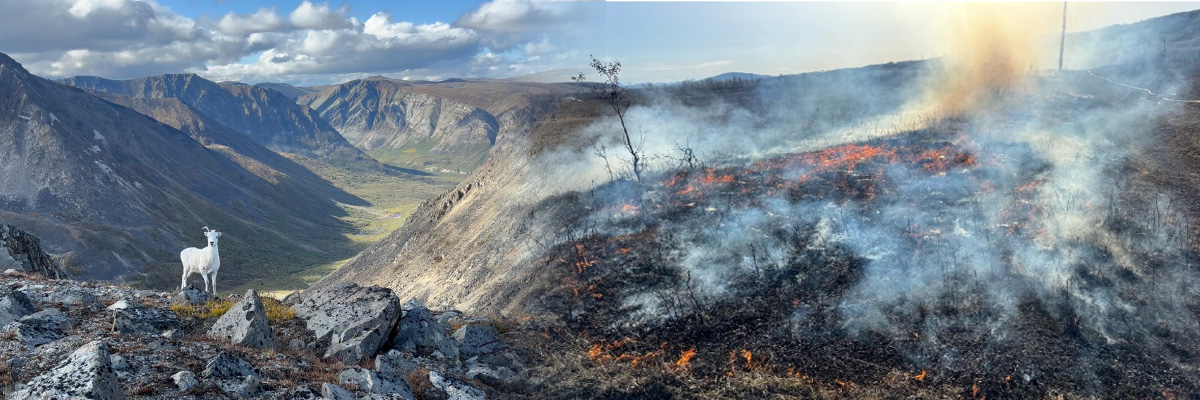
For its fiscal year 2025-26, the Wild Sheep Foundation will direct a record $2.2 million in Grant-In-Aid funding for wild sheep conservation and management projects, primarily requested through our Chapter and Affiliate network.
Twenty-five projects, spanning from British Columbia to New Mexico, Yukon to Nevada, and internationally in Central Asia, were awarded grants. The largest grants are $210,000 each to support continuation of a multi-year, tri-state comprehensive disease surveillance/management project in Idaho, Oregon, and Washington, as well as health and disease surveillance and recovery efforts in the ION project in Idaho, Oregon, and Nevada. All funded projects will benefit wild sheep populations in areas of critical need, including habitat management, water development, land acquisition, survey/inventory, and expanded pathogen surveillance and disease management. Here is a short summary on each of these Grant projects:
Ranchbot Water Monitoring - Nevada
In southern Nevada's smoldering desert, the Ranchbot Water Monitoring Initiative continues to aid desert bighorns and other wildlife by improving water reliability. Phase II expands innovative monitoring systems across remote drinkers. The technology provides real-time data to wildlife managers, ensuring water is maintained efficiently in harsh desert environments and helping sustain healthy herds in the hottest part of the driest state, where every drop matters.
 Dr. Karen Fox Genome Project (pictured here)
Dr. Karen Fox Genome Project (pictured here)
At Colorado State University, Dr. Karen Fox and her team, along with colleagues at other universities/agencies, are advancing the understanding of Mycoplasma ovipneumoniae, the deadly respiratory pathogen that impacts wild sheep throughout North America. Using whole-genome sequencing, the project standardizes strain-typing across states and agencies, thereby improving coordination and response to outbreaks. Results will help managers identify sources of infection and apply consistent disease management practices to strengthen herd health for long-term recovery.
Leonard Domestic Sheep Permit Waiver - Colorado
The Leonard Grazing Permit Waiver project retires three federal allotments in Colorado's San Juan Mountains to protect the San Juan West bighorn herd, a key population. Coordinated by the Rocky Mountain Bighorn Society, Wild Sheep Foundation, and National Wildlife Federation, this voluntary buyout reduces contact between domestic and wild sheep. The project secures critical habitat and supports long-term recovery of one of Colorado's most important native herds.
Bighorn Sheep Restoration Facility - Nebraska
This project establishes Nebraska's a bighorn sheep restoration facility to support disease testing, research, and herd recovery. The facility will house 20–30 animals for 5–10 years, providing a secure, disease-free source for future reintroductions. Led by the Nebraska Game and Parks Commission with support from the Wild Sheep Foundation, the effort addresses declining augmentation opportunities and advances understanding of respiratory disease, particularly Mycoplasma ovipneumoniae, to strengthen bighorn populations in the Pine Ridge and across the region.
Tri-State Test and Remove – Oregon, Washington, Idaho
The Tri-State Test-and-Remove Project unites wildlife agencies, tribes, and WSF chapters from Idaho, Oregon, and Washington to address disease issues in connected bighorn herds. Field teams capture, test, and remove infected animals while tracking movements and disease dynamics in Hells Canyon and nearby ranges. This regional approach reduces the risk of reinfection and promotes consistent disease management strategies across jurisdictional boundaries in the interior Northwest.

Dall's Sheep Conservation Planning - Alaska
The Alaska Wild Sheep Foundation, working with the Alaska Department of Fish and Game and the Wild Sheep Foundation, is coordinating a new planning effort to guide Dall's sheep conservation in the Western Range. Through meetings in Fairbanks and regional workshops, the project will evaluate herd conditions, identify key management needs, and outline priorities for habitat restoration and long-term monitoring to support the recovery of Alaska's mountain sheep populations.
Sierra El Álamo Water Development - Mexico
In Sonora, Mexico, the Sierra El Álamo Project is expanding the region's desert bighorn population by enhancing water infrastructure and implementing effective population management strategies. Led by Jacobo Artee with support from the Sonora Wildlife Foundation and Wild Sheep Foundation, the team is expanding a gravity-fed water system, conducting translocations, and tracking sheep with GPS collars. These actions enhance habitat use, reduce drought stress, and ensure long-term stability of desert bighorn sheep in the southern tier of their range.
Navajo Nation Bighorn Recovery – Arizona, New Mexico, Utah
restoration in the San Juan and Lake Powell regions. Biologists use helicopter captures, GPS ear tags, and diagnostic testing to study the transmission of Mycoplasma ovipneumoniae between wild and domestic sheep. The results will inform management decisions and support the development of healthy, sustainable desert bighorn populations across the Navajo Nation lands.
ION Project - Idaho, Oregon, Nevada
The Idaho–Oregon–Nevada (ION) Project is a coordinated effort to strengthen California bighorn herds across shared borderlands. Field crews conduct test-and-remove operations to manage Mycoplasma ovipneumoniae, deploy GPS collars for tracking, and restore habitats on key ranges, such as Hart Mountain. The project combines applied science and on-the-ground management to enhance herd health in a key area for the California bighorn subspecies.
Xeni Gwet'in First Nation BHS Recovery Program - British Columbia
Wild Sheep Foundation is supporting the Xeni Gwet'in First Nation's efforts to restore California bighorn populations in British Columbia's Tsilhqot'in territory. Over five years, community Guardians will monitor sheep, manage predators, and restore habitat through fire and range improvements. The project integrates traditional knowledge with Western science to recover culturally and ecologically essential herds while working toward long-term, Indigenous-led conservation.
Evaluation of Test & Remove in the Badlands - South Dakota
South Dakota State University, in partnership with Badlands National Park and the Oglala Sioux Parks and Recreation Authority, is conducting a major bighorn health study in the Badlands. Using GPS collars, disease testing, and targeted removals, researchers are managing Mycoplasma ovipneumoniae infections and tracking herd recovery. The project aims to stabilize the population, restore herd health, and support future hunting opportunities.
Socorro Field Office Guzzler Program - New Mexico
The Bureau of Land Management's Socorro Field Office, with Wild Sheep Foundation and the New Mexico Chapter WSF, is upgrading desert bighorn water systems in the Magdalena Mountains. New BOSS tanks and metal catchments will replace outdated units at Copper Canyon and Devil's Backbone. These improvements ensure reliable water access, enhance habitat connectivity, and support the ongoing population growth of a herd that has produced some impressive rams for hunters over the last few years.
“Coming Home” - Oregon to British Columbia
The "Coming Home" project returns California bighorn sheep from Oregon to their ancestral range in British Columbia. This is the same landscape that once supplied the source stock for restoration efforts across much of the western U.S. With support from the Wild Sheep Foundation and provincial partners, healthy, disease-free animals are being translocated north to rebuild herds and reconnect habitats. The effort completes a full conservation circle, restoring bighorns to the rugged country that first gave them a home in the West.
Range-Wide Test and Remove Evaluation - Idaho
Idaho Fish and Game's Frances Cassirer is leading this multi-jurisdictional study analyzing data from 26 bighorn sheep populations across North America. The project evaluates the effectiveness of test-and-remove programs in controlling Mycoplasma ovipneumoniae and promoting recovery. By integrating results from multiple regions, the research will refine management practices, improve predictive disease models, and strengthen long-term herd restoration strategies that can benefit bighorn sheep across their range.
Central Asia (WISPA-CA)
The Wild Sheep Partnership for Central Asia (WISPA-CA) builds cross-border capacity for wild sheep research and management across the Altai and Tien Shan ranges. With partners from Kazakhstan, Kyrgyzstan, Tajikistan, Mongolia, and Uzbekistan, the project trains biologists, collects genetic and disease data, and develops a regional data-sharing platform. Workshops in Kyrgyzstan will enhance collaboration and equip local conservationists to monitor and manage argali and urial populations more effectively.

Test and Remove - British Columbia
Phyla Biological Consulting, with support from WSF and the Wild Sheep Society of BC, is expanding test-and-remove programs for California bighorns across the Fraser and Okanagan regions. Crews will set out to capture, collar, and test sheep to manage Mycoplasma ovipneumoniae, track movements, and assess recovery. The project strengthens coordination among First Nations, biologists, and hunters, promoting science-based disease control and herd restoration.
Aoudad Control - Texas
In Texas's Trans-Pecos region, this project aims to reduce invasive aoudad (Barbary sheep) populations that compete with desert bighorn sheep, spread disease, and degrade habitat. Using mobile corral traps, remote cameras, and aerial removals, the effort focuses on improving forage conditions and herd health across key ranges. Wild Sheep Foundation funding supports work led by the Texas Bighorn Society and the Texas Parks and Wildlife Department.
Movi Surveillance - Yukon
For over a decade, the Yukon Wild Sheep Foundation, with support from the Wild Sheep Foundation, has led a proactive disease surveillance program for thinhorn sheep. Nearly 900 hunter-harvested animals have been tested for Mycoplasma ovipneumoniae, with no positives to date. This long-term monitoring provides essential assurance of herd health and helps maintain Yukon's global reputation for disease-free wild sheep populations through continued hunter participation and scientific oversight.
Prescribed Burns Planning - Yukon
In Yukon's mountain valleys, dense vegetation is crowding out the open slopes that thinhorn sheep depend on. Working with local agencies and communities, this project intends to use carefully planned prescribed burns to restore native grasslands and winter range. These treatments will enhance forage quality, mitigate predation risk, and preserve the natural fire cycles that support healthy populations of thinhorn sheep and other ungulates in this stunning landscape.

YOA Ungulate Enhancement – Yukon
In Yukon’s wild landscapes, healthy ungulate herds are the foundation of both ecosystems and traditions. The Yukon Outfitters Association champions ungulate enhancement through practical, science-based measures that balance predator management, habitat stewardship, and sustainable harvest. By supporting programs that reduce predation pressure, maintain habitat integrity, and engage local knowledge, YOA helps ensure resilient sheep, moose, and caribou populations. These efforts safeguard not only wildlife, but also the cultural and economic values tied to Yukon’s land and people.
Muddy Mountains Desert Bighorn Capture and Response - Nevada
In Nevada's Muddy Mountains, the Nevada Department of Wildlife conducted emergency captures and health assessments of desert bighorn sheep in response to herd health concerns. Using helicopters and field testing, biologists evaluate animals for disease, provide treatment when possible, and translocate healthy individuals to bolster other herds across the state. Supported by the Wild Sheep Foundation, the effort reduces local stress, strengthens genetic diversity in different areas, and contributes to overall desert bighorn health across the Southwest.
Prescribed Fire for Thinhorn Sheep Habitat Enhancement – Yukon
Across the Yukon's thinhorn sheep habitat, encroaching shrubs and trees are reducing critical forage. This project applies prescribed burning to expand open feeding areas and reduce wildfire fuel loads. Led by territorial biologists with support from the Wild Sheep Foundation, the effort combines traditional fire knowledge and modern habitat management to sustain healthy habitats for thinhorn sheep in these remote northern wildlands.
WSF Guzzler Maintenance and Improvements - Utah
Utah WSF is initiating a statewide program to inspect, maintain, and improve existing guzzlers across bighorn sheep units to ensure reliable water sources and accurate data. Partnering with the Utah Division of Wildlife Resources, Utah Department of Natural Resources, Bureau of Land Management, and the U.S. Forest Service, the Foundation will verify and update guzzler records, conduct helicopter-assisted site inspections, and install remote water-monitoring systems to enhance management and long-term habitat sustainability.
Vulcan Mountain Helicopter Logging - Washington
On Washington's Vulcan Mountain near the Methow Valley, dense conifer encroachment has reduced open grass–shrub habitat critical for the state's bighorn sheep. This project uses targeted helicopter logging to remove timber on steep slopes that are inaccessible by road. The treatments will reopen historic range, improve nutrition and enhance wild sheep's ability to see predators like mountain lions.
NWSGC Biennial Symposium 2026 - Nevada
The 2026 Northern Wild Sheep and Goat Council Symposium, to be held in Elko, Nevada, will bring together wildlife managers, biologists, and conservationists from across North America. Supported by the Wild Sheep Foundation, this event serves as a platform for sharing new research, management strategies, and field experiences. The gathering helps unify efforts to improve the conservation of wild sheep and mountain goats across the continent.
Tags: Grant-in-Aid